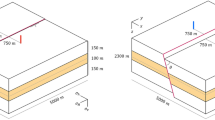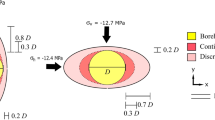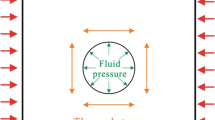Abstract
The numerical dynamic model of Chinese mainland lithosphere’s stress and strain field was constructed with elasto-viscous creep constitutive relation. The most recent data of the stress field of Chinese mainland and the horizontal movement velocity of the crust blocks were used as constraint conditions. The values of the boundary force were computed by trial-and-error method. The effect of the Qinghai-Xizang Plateau’s excess potential energy to the movement of Chinese mainland was studied also in this model. The results of the numerical computing show that, recent rapid raising of the Qinghai-Xizang Plateau and the generation of normal faults in the southern part of the plateau resulted from the convergence of Indian Plate to the Eurasian Plate, and also from the rapid convective thinning of the lower lithosphere. Horizontal extension of the Qinghai-Xizang Plateau is the main dynamic factor to form the present tectonic framework of the Chinese mainland. The compressive loads on the eastern boundary of the model were mainly applied by the subduction of the Pacific Plate. The compression from the Philippine Plate maybe slight.
Similar content being viewed by others
References
Dewey J F, Shackleton R M, Chang C F, et al. 1990. The tectonic evolution of the Qinghai-Xizang Plateau. The Geological Evolution of the Qinghai-Xizang Plateau. Beijing: Science Publishing House, 384–415 (in Chinese)
Ding G Y eds. 1991. Lithosphere Dynamics of China Explanatory Notes for Atlas of Lithosphere Dynamics of China. Beijing: Seismological Press, 123–141
England P C, Houseman G A. 1988. The mechanics of the Tibetan Plateau. Philos Trans R Soc London, Ser A, 326: 301–319
England P C, Houseman G A. 1989. Extension during continental convergence, with application to the Tibetan Plateau. J Geophys Res, 94(B12): 17 561–17 579
Kerr R A. 1995. Bigger jolts are on the way for Southern California. Science, 267: 176–177
Kerr R A. 1996. Seismologists learn the language of quakes. Science, 271: 910–911
Kusznir N J, Bott M H P. 1977. Stress concentration in the upper lithosphere caused by underlying visco-elastic creep. Tectonophysics, 43: 247–256
Kusznir N J, Park R G. 1986. Continental lithosphere strength: the critical role of lower crustal deformation. In: Dawson J B, Carswell D A, Hall J, et al eds. The Nature of the Lower Continental Crust. Geological Society Special Publication. Oxford: Blackwell Scientific Publications, (24): 79–93
Mei S R, Liang B Y. 1989. A mathematical simulation for seismogenetic process of the Tangshan earthquakes. Earthquake Research in China, 5(3): 9–17 (in Chinese)
Molnar P, Lyon-Caen H. 1989. Fault plane solutions of earthquakes and active tectonics of the Tibetan Plateau and its margins. Geophys J Int, 99: 123–153
Molnar P, England P, Martinod J. 1993. Mantle dynamics, uplift of the Tibetan Plateau, and the Indian monsoon. Rev Geophy, 31(4): 357–396
Post R L, Jr. 1977. High temperature creep of Mt. Brunett dunite. Tectonophysics, 42(2–4): 75–110
Shelton G, Tullis J. 1981. Experimental flow laws for crustal rocks. EOS Trans Amer Geophys Un, 62: 396
Wang S Y, Xu Z H, Ge M. 1987. Seismotectonic stress field in eastern sea area of China. Earthquake Research in China, 3(3): 18–25 (in Chinese)
Xu Z H, Wu S W. 1997. A study of present-day tectonic stress in the southern Yellow Sea and East China Sea region. Acta Geophysica Sinica, 40(6): 774–781 (in Chinese)
Zhang D N, Gao L S. 1989. Three dimensional numerical simulation of the stress field in East Asia. Earth Research in China, 5(4): 24–33 (in Chinese)
Zhang D N, Xu Z H. 1995. Possible dynamics of normal fault earthquakes in the upper crust of the south part of the Qinghai-Xizang Plateau. Acta Seismologica Sinica, 8(2): 233–239
Zhang D N, Xu Z H. 1997. Numerical simulation of the graben forming process in the south part of the Qinghai-Xizang Plateau. Earth Research in China, 13(4): 349–357 (in Chinese)
Zhang D N, Zeng R S. 1995. Numerical simulation of the detachment dynamics in North China Basin. Acta Seismologica Sinica, 8(4): 511–517
Zhang G M, Fu Z X. 1985. Time sequences of strong earthquakes in North China and their explanation. Acta Geophysica Sinica, 28(6): 569–578 (in Chinese)
Zhou S Y, Zhang Y G, Ding G Y, et al. 1998. A preliminary research establishing the present-time intraplate blocks movement model on Chinese mainland based on GPS data. Acta Seismologica Sinica, 11(4): 403–412
Zhu H B, Zhou W W, Wu L G. 1985. Characteristics of the gravity field on the Qinghai-Xizang Plateau and their implications in tectonics. Acta Geophysica Sinica, 28(Supp I): 60–70 (in Chinese)
Author information
Authors and Affiliations
Additional information
Contribution No. 99FC2011, Institute of Geophysics, China Seismological Bureau.
About this article
Cite this article
Zhang, DN., Xu, ZH. Boundary conditions of the dynamic numerical model for the Chinese mainland lithosphere. Acta Seimol. Sin. 12, 148–154 (1999). https://doi.org/10.1007/s11589-999-0019-0
Received:
Revised:
Accepted:
Issue Date:
DOI: https://doi.org/10.1007/s11589-999-0019-0




